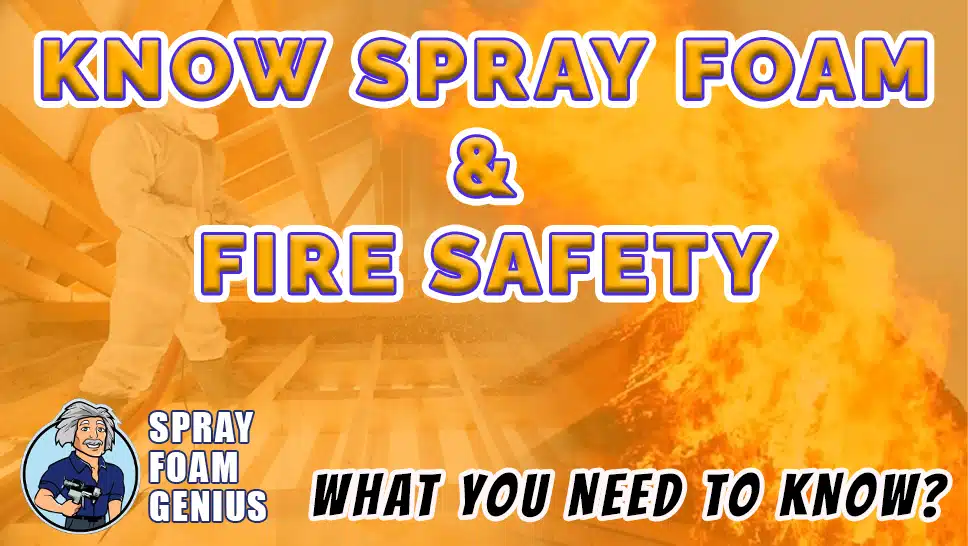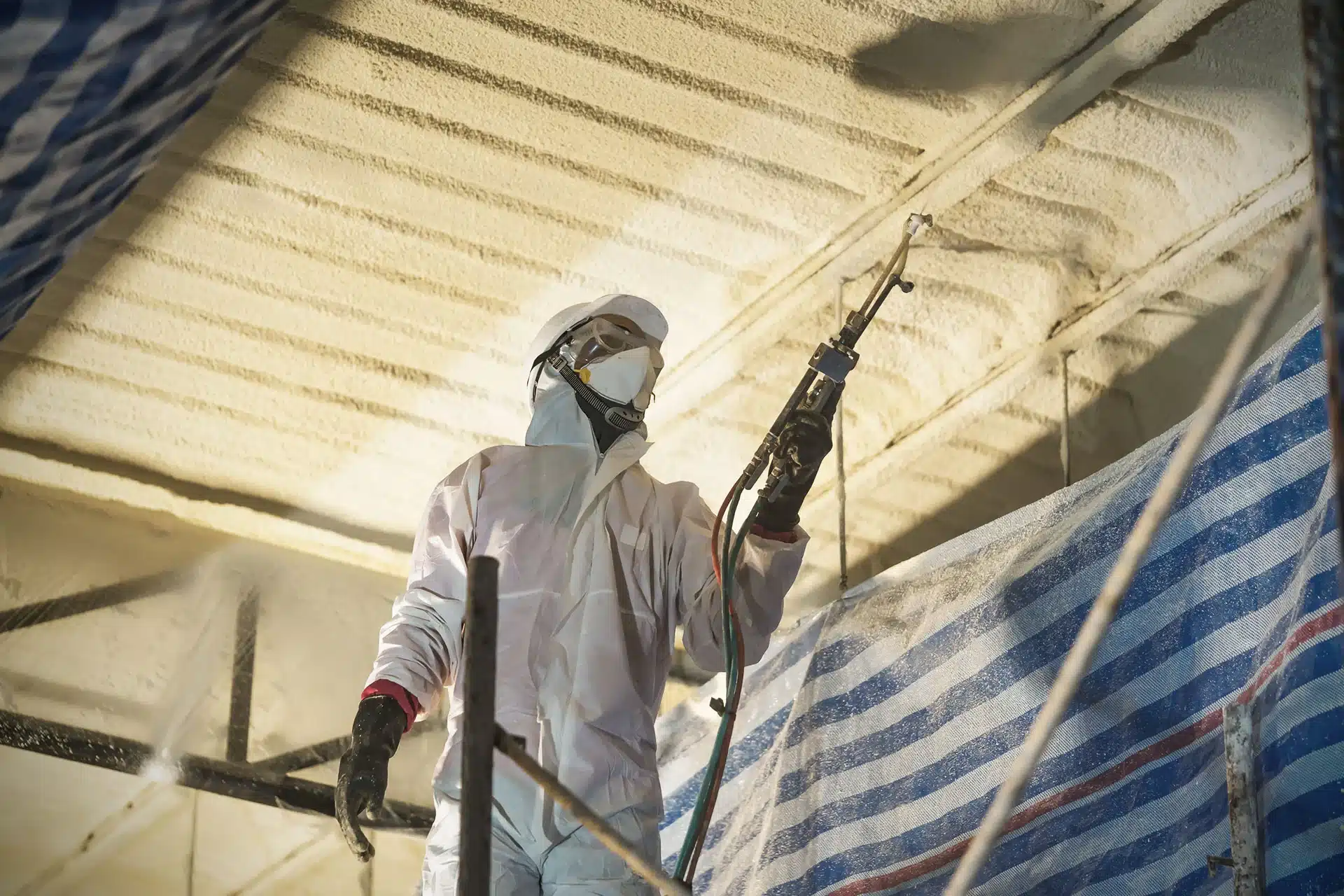
In recent years, spray foam insulation has become increasingly popular for both residential and commercial properties in the United States and Canada. Known for its superior energy efficiency, excellent sealing properties, and long-lasting durability, spray foam insulation offers numerous benefits. However, as with any building material, understanding its interaction with fire safety standards is crucial. Whether you’re a homeowner, business owner, or contractor, it’s essential to be well-informed about the fire safety aspects of spray foam insulation.
At Spray Foam Genius Marketing, we provide digital marketing services exclusively for spray foam insulation contractors. Our deep industry knowledge allows us to deliver high-quality content that addresses the needs of both contractors and their clients. In this blog post, we’ll cover everything you need to know about spray foam insulation and fire safety, focusing on regulatory compliance, best practices, and key considerations to ensure your property is safe and secure.
Understanding Spray Foam Insulation: Types and Benefits
Spray foam insulation comes in two primary types: open-cell and closed-cell. Each type has unique properties that make it suitable for different applications.
1. Open-Cell Spray Foam Insulation: Open-cell foam is lighter, more flexible, and has a lower R-value compared to closed-cell foam. It is excellent for soundproofing and is often used on interior walls. Because it is less dense, it is also more affordable.
2. Closed-Cell Spray Foam Insulation: Closed-cell foam is denser and provides a higher R-value, making it ideal for applications where maximum insulation is required. It also offers additional structural strength, and moisture resistance, and is typically used in exterior walls, roofs, and other areas exposed to the elements.
Both types of spray foam insulation create an air-tight seal that improves energy efficiency reduces utility bills and enhances indoor comfort. However, when considering spray foam insulation, it’s important to understand its behavior in the event of a fire.
Spray Foam Insulation and Fire Safety: An Overview
Spray foam insulation, like many building materials, can be combustible. Therefore, understanding the fire safety regulations and how to mitigate fire risks is essential. The fire safety of spray foam insulation depends on several factors, including the type of foam used, the presence of fire retardants, the application method, and the building’s design and construction.
Regulatory Requirements: Building Codes and Fire Safety Standards
In the United States and Canada, spray foam insulation must comply with stringent fire safety regulations outlined by national and local building codes. The two primary codes governing the use of spray foam insulation are:
1. The International Building Code (IBC):
The IBC is widely adopted in the United States and provides comprehensive fire safety standards for building materials, including spray foam insulation. According to the IBC, all foam plastic insulation, including spray foam, must be separated from the interior of a building by a thermal barrier, such as drywall, to prevent it from igniting during a fire.
2. The National Building Code of Canada (NBCC):
Similar to the IBC, the NBCC sets out fire safety standards for building materials in Canada. The NBCC also requires that spray foam insulation be protected by a thermal barrier unless specific conditions are met, such as when the insulation is applied in a cavity wall that meets certain fire-resistance ratings.
Thermal Barriers:
Thermal barriers are critical in ensuring the fire safety of spray foam insulation. These barriers, typically made of gypsum board or other approved materials, are designed to delay the spread of fire and provide occupants with additional time to evacuate the building. The IBC and NBCC generally require a thermal barrier with a minimum thickness of 1/2 inch (12.7 mm) when spraying foam insulation is used in occupied spaces.
Ignition Barriers:
In addition to thermal barriers, ignition barriers may be required in certain applications, such as attics and crawl spaces. Unlike thermal barriers, which are designed to withstand high temperatures for an extended period, ignition barriers are intended to prevent the ignition of spray foam insulation when exposed to a small flame or spark. Common materials used as ignition barriers include plywood, particleboard, and specific fire-retardant coatings.
The Role of Fire Retardants in Spray Foam Insulation

To enhance the fire safety of spray foam insulation, manufacturers often incorporate fire retardants into the foam’s formulation. Fire retardants help slow the spread of flames and reduce the amount of smoke produced during a fire. While fire retardants significantly improve the safety of spray foam insulation, they do not make it completely fireproof. Therefore, proper installation and the use of thermal barriers remain essential.
It’s also important to note that the effectiveness of fire retardants can vary depending on the type and concentration used in the spray foam. When selecting spray foam insulation for your project, it’s crucial to choose products that meet or exceed the fire safety standards outlined by local building codes.
Installation Best Practices for Fire Safety
Proper installation of spray foam insulation is key to ensuring fire safety. Whether you’re working on a residential or commercial project, following these best practices can help mitigate fire risks:
1. Hire Certified Professionals: Spray foam insulation should always be installed by certified professionals who are trained in fire safety protocols. Improper installation can lead to gaps, voids, or uneven coverage, which can compromise the insulation’s fire performance.
2. Use Approved Materials: Always use spray foam insulation products that are approved by regulatory authorities and meet the required fire safety standards. Check for certifications such as UL (Underwriters Laboratories) or FM Global approval, which indicate that the product has been tested for fire safety.
3. Ensure Adequate Ventilation: During installation, it’s important to ensure adequate ventilation in the work area. Spray foam insulation emits gases during application that can be hazardous if inhaled. Proper ventilation helps protect the health of installers and reduces the risk of fire.
4. Apply Thermal Barriers: As mentioned earlier, thermal barriers are critical in protecting spray foam insulation from fire. Ensure that all areas where spray foam is applied are covered with the appropriate thermal barrier material.
5. Conduct Regular Inspections: After installation, it’s important to conduct regular inspections to ensure that the spray foam insulation and thermal barriers are in good condition. Over time, wear and tear or accidental damage can compromise the fire safety of the insulation. Regular inspections help identify and address any issues before they become serious problems.
Common Misconceptions About Spray Foam Insulation and Fire Safety
Despite its popularity, there are several misconceptions about the fire safety of spray foam insulation. Let’s address some of the most common myths:
Myth 1: Spray Foam Insulation is Fireproof One of the most common misconceptions is that spray foam insulation is fireproof. While spray foam insulation can include fire retardants that help slow the spread of flames, it is not entirely fireproof. It can ignite and burn if exposed to a sufficient heat source, which is why thermal barriers are required.
Myth 2: Fire Retardants Eliminate the Need for Thermal Barriers Another misconception is that the presence of fire retardants in spray foam insulation eliminates the need for thermal barriers. This is not true. Fire retardants improve the safety of spray foam insulation, but they do not provide the same level of protection as a thermal barrier. Building codes require the use of thermal barriers to ensure that spray foam insulation performs safely in a fire.
Myth 3: Spray Foam Insulation Releases Toxic Fumes When Burned Some people believe that spray foam insulation releases highly toxic fumes when burned. While burning spray foam can produce smoke and gases, the levels of toxicity are comparable to other common building materials. It’s important to note that modern spray foam products are formulated to minimize the release of harmful chemicals during a fire.
Ensuring Compliance and Safety: What Property Owners Need to Know
For property owners, ensuring compliance with fire safety regulations is not just about meeting legal requirements; it’s about protecting lives and property. Here are some key steps you can take to ensure that your spray foam insulation meets fire safety standards:
1. Consult with a Professional: Before installing spray foam insulation, consult with a professional who is knowledgeable about local building codes and fire safety regulations. They can help you choose the right type of insulation and ensure that it is installed correctly.
2. Verify Product Certifications: When selecting spray foam insulation, verify that the product has the necessary certifications for fire safety. Look for labels from recognized testing organizations such as UL or FM Global.
3. Stay Informed: Building codes and fire safety standards can change over time. Stay informed about the latest regulations in your area to ensure that your property remains compliant.
4. Be Proactive: Fire safety is an ongoing responsibility. Be proactive by scheduling regular inspections, maintaining thermal barriers, and addressing any potential fire hazards on your property.
Contact Us to Learn More About Spray Foam Insulation and Fire Safety
At Spray Foam Genius Marketing, we understand the importance of fire safety when it comes to spray foam insulation. Our team is dedicated to helping spray foam insulation contractors succeed by providing expert marketing services that drive results. If you have questions about spray foam insulation and fire safety or need assistance with your marketing efforts, we’re here to help. Contact us today at 877-840-FOAM for USA and 844-741-FOAM for Canada, visit our website at https://sprayfoamgeniusmarketing.com/, or email us at [email protected]. Let’s work together to create safer, more energy-efficient buildings for everyone.
- How to Use Pinterest to Market Your Spray Foam Insulation Services - December 27, 2023
- How to Use LinkedIn to Grow Your Spray Foam Insulation Business - December 23, 2023
- How to Use Instagram to Showcase Your Spray Foam Insulation Projects - December 16, 2023

